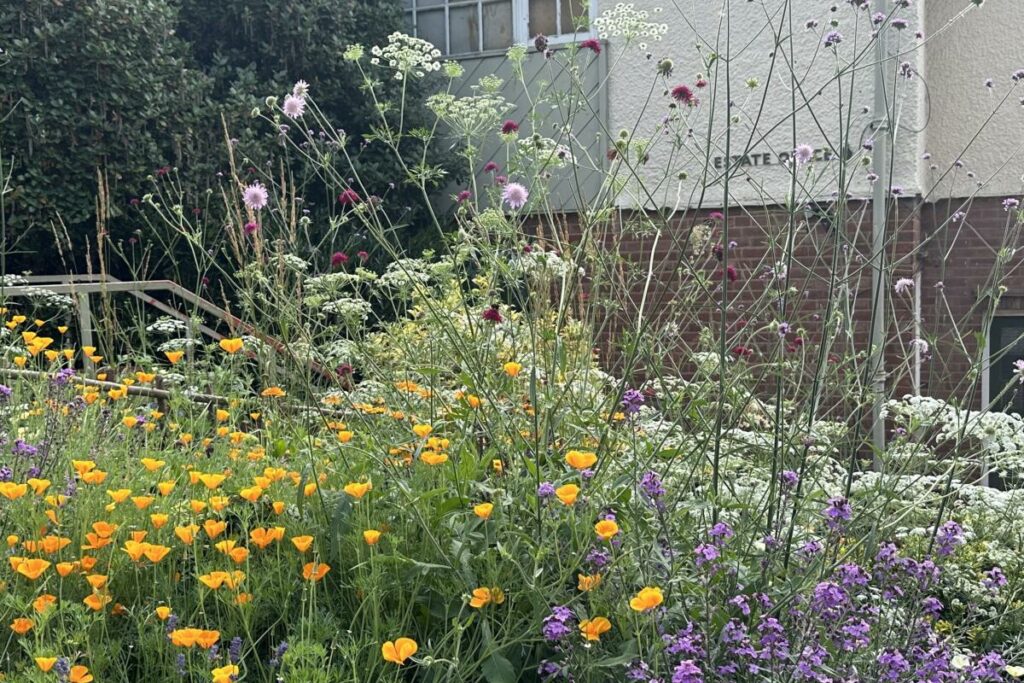
The Moor Pool Heritage Trustees set me quite a challenge – to make the planting around Moor Pool Halls more wildlife friendly while keeping it low maintenance as well as looking good for residents and visitors. Just the idea had me jumping with excitement! I knew I would also have to take into account climate change which is affecting the range of plants we can grow while, at the same time, I wanted at least a nod in the direction of Arts and Crafts style to complement the Halls.
The Trustees agreed we should make a start with the triangular raised bed between the steps and ramp down to Lower Hall. The former Moor Pool in Bloom group agreed to buy the plants. Gardeners from Nettlefold Garden and the Eco Centre joined in and suddenly we had a team.
Work began in March 2024. The first step was to remove most of the old shrubs from that triangular bed. This revealed an uneven shaped bed on a very steep slope with virtually no soil – just sand with builders’ rubble below! Sand is not a great problem – recent experimental work has shown that, provided there are some nutrients, many plants will grow well on it. A soil test showed it was neutral to alkaline. All of this helps us work out which plants to choose.
Before we could start on the planting, we needed to make sure that the soil itself would be wildlife friendly. Soil needs to be alive with micro-organisms, fungi, beetles etc for it to be a really healthy place for plants to grow. So, the first thing we did was dig a trench across the bed and bury some old logs. These will help prevent soil sliding down the slope but will also rot down, acting as slow-release fertiliser and creating homes for micro-organisms. Then, we added 15 bags of soil conditioner. For the best results this would have been fresh, home-made compost but bags of conditioner are the next best thing.
In creating a design for the bed I wanted to add some structure. I had some lengths of hazel fencing from a previous project which would help retain the soil, would provide support for some of the plants, and add something visually to the oddly shaped bed. Being natural material they will also gradually rot down. Some more logs would add a finishing touch. We had saved these from the recent trimming of the silver birches next to the Hall. Silver birch bark is really lovely and makes a great feature among the plants.
‘Right plant, right place’ is the garden designer’s mantra – this means choosing plants that like the soil, the amount of light and moisture of a location. Plants that need an acid soil, like heathers and azaleas, wouldn’t thrive here so I chose lime lovers, such as lavender and a prostrate rosemary. Other plants include eryngium, achillea, salvia, and cirsium. There are ground cover plants – marjoram and erigeron. And finally, some annuals to make a splash and fill the space while other plants grew – mainly California poppies and marigolds. We finished it all off with a mulch of fine bark. This looks nice but the main function is to help retain moisture.
To start with, the planting looked sparce but by midsummer the bed was burgeoning with growth and colour and with bees! When Autumn came, I pulled out the annuals – hopefully they will have seeded for next year. And I’m delighted that some fungi are already in evidence – a great sign that the planting will prosper!
But the Trustees’ challenge was to look at the planting all round the Halls! Next step is the area beside the new ramp by the north door to the Main Hall. It’s a challenging position because it’s north facing and very dry shade under the birch trees. But there’s a new area waiting to be planted and I’m going for bergenias (a Gertrude Jekyll favourite), the old-fashioned white daffodil Narcissus ‘Thalia’, and Gillenia trifoliata ‘Pink Profusion’ (a pretty, herbaceous perennial that flowers in summer and tolerates shade). Other plants to look out for are the winter-flowering Sarcococca confusa and spring-flowering epimediums.
During the winter we’ve moved round to the south east corner, to the left of the shops. Stage 1 is removing most of the laurel. Although laurel fills a space with evergreen it is sadly of very little use to wildlife. Getting the roots out has been quite a task but we’ll soon be ready to improve the soil and then plant Viburnum tinus ‘Gwenllian’. This is a medium sized shrub, evergreen but with pretty pink flowers in winter for any late, or early, invertebrates.
No wildlife planting these days would be complete without a bug hotel and members of Moor Pool Wildlife have risen to the challenge! A hotel is being designed that picks up the Arts & Crafts architectural features of the Hall and which will be built using recycled materials from the estate.
So, it’s very much a case of ‘watch this space’. I hope you are enjoying the changes as we take the wildlife friendly planting right around The Circle!
Cathy Perry and Moor Pool Wildlife
nettlefoldgarden@gmail.com
Moor Pool Hall
37 The Circle, Harborne,
Birmingham, B17 9DY
Registered Charity Number: 1148252
© 2025 All rights reserved | Website by Citrus Frog